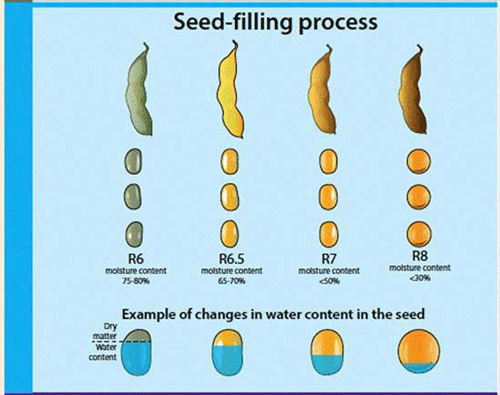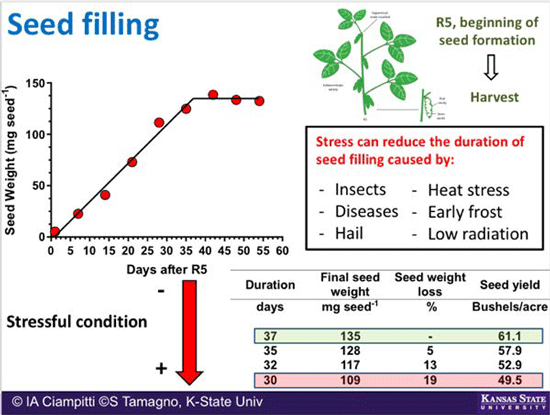The latest USDA-National Agricultural Statistics Service crop progress and condition report, released September 14, 2025, classified 79% of the soybean crop as being in fair (24%) or good (55%) condition. Overall, 24% of all soybeans in Kansas are dropping leaves, behind both last year and the 5-year average of 35%.
Weather outlook
The weather conditions expected for the last portion of September will be critical for soybeans as they relate to seed filling and determining the final seed weight.
Despite temperatures averaging 6.5°F below normal for the first week of September, above normal readings since that time have raised the departure from normal for the first half of September to 1.4°F below normal, based on data from the Kansas Mesonet. The 8 to 14-day outlook strongly favors above-normal temperatures, and the month is likely to finish above normal. There are no immediate threats of frost or freezing conditions in the forecast anywhere in the state.
Precipitation has been quite variable around the state in September. Parts of Lincoln and Ellsworth County have received over 9 inches of rain this month, and central Kansas has been the wettest division so far this month. Meanwhile, parts of northwest Kansas have had little precipitation. Towns like Atwood and Oberlin have received less than one-quarter inch of rain this month. Precipitation is likely statewide in the next few days, with amounts over one inch possible in eastern Kansas. The precise location of the heaviest rainfall is still uncertain, as recent forecast model runs have not been consistent with respect to the placement of the heaviest precipitation. Below-normal precipitation is slightly favored in western Kansas for the last week of September, with equal chances of above, below, and near normal precipitation in eastern Kansas. Seasonally, we continue the weekly decrease in normal precipitation as we head towards the driest season of the year (winter). As a result, below-average precipitation means potentially very little, if any, moisture. Warm and dry conditions will favor overall low humidity, increasing drought, and wide day/night temperature swings.
Soybean seed-filling
Final maturity is defined as the formation of the black layer in the seeds. Soybeans will reach final maturity with high seed water content, moving from 75-80% (R6) to around 50% (R7) from the beginning of seed filling until final maturity (Figure 1). Seed dry matter accumulation and moisture changes depend on the maturity group, planting date, and weather conditions experienced during these stated reproductive phases.
Soybean seed water loss can be divided into two main phases: 1) before “black layer” or maturity, and 2) after black layer.
The overall contribution of seed weight to final yields can be studied by evaluating changes in seed weight during the seed-filling period (Figure 2). Overall, a seed-filling period of more than one month duration (37 days) until black layer was achieved (this is the reference for changes in seed weight). The graph of seed filling provides a visual of the overall rate, increase in seed weight per day, and the duration of the seed filling.
From this example, we can observe that when the duration is reduced by one week (from 37 to 30 days), the attainable yield goes from 61 to roughly 50 bushels per acre. Potential factors (beyond the current heat/dry conditions) impacting the duration of leaf green area imposed by insects, diseases, hailstorms, and any other abiotic stress conditions, such as cloudy days and early frost, impacting the crop during the coming weeks, will negatively affect the seed filling conditions for soybeans.
For this current season, we could expect negative yield impacts due to the last heat wave combined with areas of droughty conditions, which resulted in poor seed weight and potentially increased late pods and seed abortion. Overall, seed weight contributes roughly 30-40% of the final total yield for this crop, emphasizing the impacts of the stress conditions on the attainable yields.

Figure 1. The soybean seed filling process from full seed to full maturity. Graphic from the K-State Research and Extension Soybean Growth and Development poster, MF3339.

Figure 2. Soybean seed weight changes from the beginning of seed filling (R5) to full maturity.
Soybean dry down rate
Soybeans reach final maturity with high seed water content, moving from 90% to around 60% from the beginning of seed filling until final maturity. The dry down rate will depend on the maturity group (affecting the length of the season), planting date, and weather conditions experienced during pod and seed set phases.
K-State researchers conducted a trial in 2016 investigating the water content changes from black layer formation until harvest time. The overall dry down rate was 3% per day over a 15-day period (late September to mid-October). The trial started with soybeans at 58% and ended at 12% to find the 3% per day. The 3% per day is three times faster compared to corn’s 1% moisture daily loss. However, corn and soybean dry down rates are primarily driven by temperature, humidity, and overall water content at the point of black layer formation. These main factors should be considered when scheduling the soybean harvest, where we are aiming for 13% moisture.
Some areas of soybean production have been faced with droughty conditions, while others have been consistently hit with rain. Scouting your fields for maturity and prioritizing situations with lodging or other stress factors should be considered for harvestability. Some soybeans entering maturity could be harvestable in two weeks due to the dry down speed.
Tina Sullivan, Northeast Area Agronomist
tsullivan@ksu.edu
Matthew Sittel, Assistant State Climatologist
msittel@ksu.edu
Tags: soybeans growth stage dry down